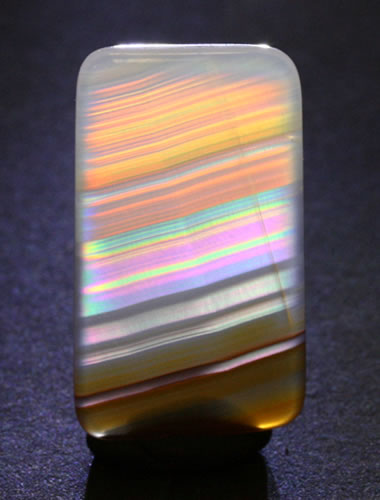Iris Agate
Iris agate is a finely-banded agate that can produces a rainbow of color from a diffraction grating effect. What is Iris Agate?"Iris Agate" is a name used for a finely-banded agate that produces a spectacular display of color when it is cut properly and illuminated from a direction that sends light through its very thin bands. The name "iris agate" is used because one meaning of the word "iris" is "a rainbow-like display of colors".A specimen of iris agate is shown in the pair of photographs in Figure 1 on the right side of this page. This specimen is a thin slice of agate that measures about 25 mm high, 14 mm wide and 3 mm in thickness. The agate is very finely banded. The parts of the agate that produce the iris effect are translucent to transparent and have at least 15 to 30 bands per millimeter that are countable under a gemological microscope. Some parts of the agate have a higher density of bands but they cannot be counted because they are very thin and the agate is milky. Reflected Light and Backlight ViewsThe photo on the left side of Figure 1 shows the iris agate specimen under normal illumination. The colors that you see in this photo are mainly colors of light reflected from the surface of the agate.The photo on the right side of Figure 1 shows the same specimen; however, in this photo the source of light is behind the specimen. The colors that you see in this photo are produced by light that is transmitted through the agate. These colors are very different from the reflected light view and very different from the body color of the agate. They are produced by an optical phenomenon known as diffraction. When light strikes the agate it encounters the edges of the tiny bands. These bands disrupt the flow of light and the rays of light take many separate paths through the thin bands of the agate. The bands act as a natural diffraction grating that diffracts the light and produces a display of spectral colors. How to Cut, Observe and Display Iris AgateMost agates will not produce an iris effect. Candidates are those which are very finely banded and nearly transparent. They must be sliced so that the sawn surface is perpendicular to the banding of the agate. The thinner they are sliced the stronger the spectral colors. (Our slice at 3 millimeters is thicker than optimal and shows higher order colors instead of primary colors.) The surface of the agate should be brightly polished to allow the easy entry of light without the scattering caused by an unpolished surface.To observe the iris effect the agate must be positioned between the observer and a light source with the rays of light striking the surface of the agate perpendicular to the polished surface. At that angle a maximum amount of light will enter the agate. Iris agates can be placed on a display stand or dangled on a string in front of a sunny window. They can be mounted in a display case with backlighting. Some people display iris agate in jewelry. The requirement for backlighting prohibits a good spectral display in a ring, pin or brooch. The stone must be suspended to have a light source and observer on opposite sides of the stone. The best jewelry use is in earrings. Unappreciated Iris AgateSpecimens of iris agate are not often seen in museums and mineral shows. However, they are probably much more common than most people realize. Most agate slabs are cut too thick to produce a strong iris effect (the thinner the slab the stronger the colors) and many thinly-sliced agates are not observed in a way that reveals the iris effect. So, if you have some thinly-banded agate that is on the translucent to transparent, cut a thin slice to see if there is a rainbow inside.Contributor: Hobart King http://geology.com/stories/13/iris-agate/
| 

|
--
__._,_.___
No comments:
Post a Comment